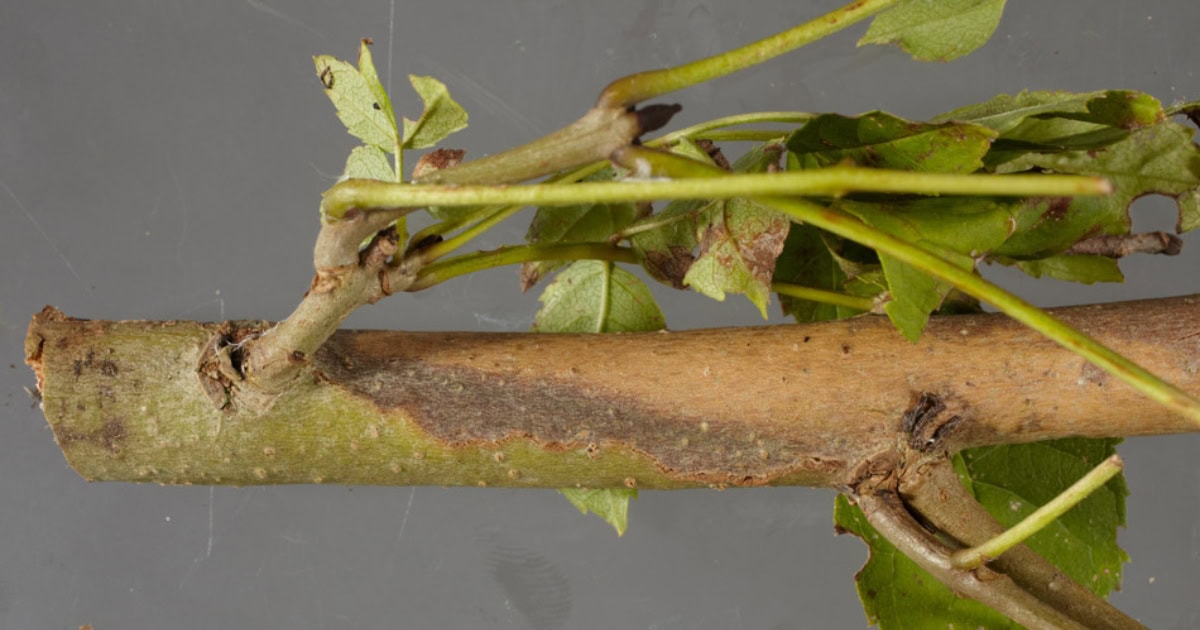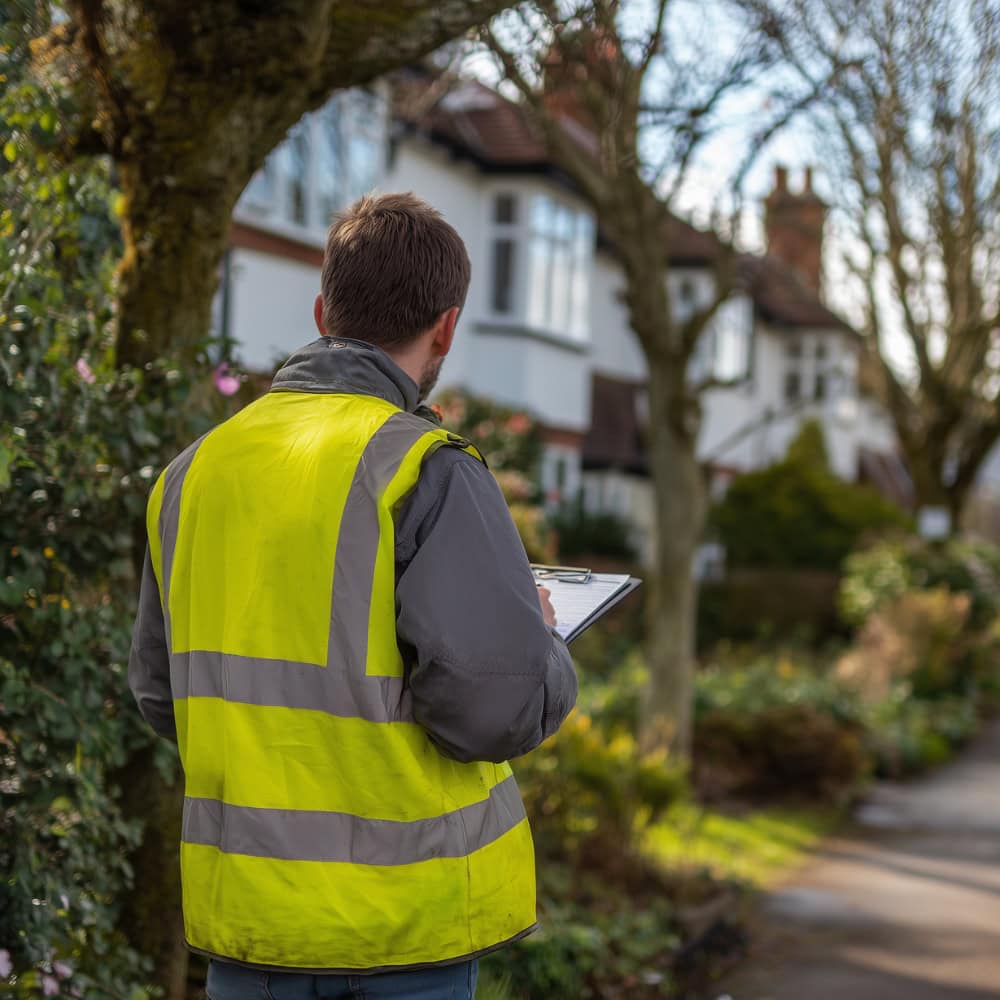Ash dieback vs H. albidus: native lookalike, different behaviour
Ash dieback gets the headlines—and rightly so. But there’s a curveball: a native fungus, Hymenoscyphus albidus, produces tiny white cup-shaped fruiting bodies on last year’s ash leaf stalks that look much like those linked to ash dieback. One of these species drives lesions and crown loss; the other mostly tidies up fallen leaves. Knowing the difference helps you decide whether to budget for urgent work or simply monitor. This guide explains the signs, shows where field ID stops and lab tests start, and sets out sensible next steps for UK tree owners. For background on symptoms and management, Forest Research and the Forestry Commission host the most up-to-date guidance for Britain. Forest ResearchGOV.UK
Ash dieback disease — what does ash dieback look like?
Ash dieback is caused by Hymenoscyphus fraxineus (formerly H. pseudoalbidus), a fungus introduced to Europe from Asia. It infects ash leaves in summer, moves into shoots and sometimes stems, and over time can cause progressive dieback and, in some trees, death. In the UK it is now widely established, and official guidance is updated periodically with identification and management advice. bsppjournals.onlinelibrary.wiley.comGOV.UK
What to look for (mid–late summer is best):
- Leaves and shoots: wilting, blackening and death of new growth; leaves hang limp and dark rather than simply turning autumnal.
- Lesions at unions: dark, often diamond-shaped lesions where small branches/suckers meet older wood; cracking may form as the tree grows around earlier damage.
- Inner bark: beneath suspect lesions, brown-grey discolouration in the sapwood/inner bark.
- Crown: thinning over successive seasons; dead tips; epicormic shoots lower on the trunk as the tree tries to recover.
For clear examples, Forest Research maintains an illustrated symptom page (“Chalara manual — Pictures”). Forest Research
How it spreads. In early–mid summer, the fungus produces tiny white cups (apothecia) on last year’s fallen ash leaf stalks (rachises). These release wind-borne spores that infect new foliage. This litter-based life stage is key to the confusion with the native lookalike. bsppjournals.onlinelibrary.wiley.com
Meet the ash dieback lookalike: Hymenoscyphus albidus
H. albidus is native to Europe and primarily saprotrophic—it lives on dead or senescing ash leaf tissue on the woodland floor. It also forms small white apothecia on fallen rachises, often later in the season. Crucially, it is not the driver of the classic stem lesions and progressive crown decline we call ash dieback. Comparative research (morphology, genetics and genomes) consistently separates the two species and characterises H. albidus as non-pathogenic to living ash tissues. PMC+2PMC+2
Ash dieback lookalike vs real disease: field clues you can use
You can’t confirm the species by eye alone, but these cues are useful for a walk-round assessment:
|
Feature
|
True ash dieback (H. fraxineus)
|
Lookalike (H. albidus)
|
|
Impact on living tree
|
Pathogenic: infections progress from leaves to shoots/stems; lesions and dieback; crown thinning over time.
|
Mostly saprotrophic on fallen/senescing leaf tissue; no progressive crown decline attributable to this species.
|
|
Seasonal timing
|
Leaf/shoot symptoms mid–late summer; apothecia on previous year’s rachises early–mid summer.
|
Fruits on rachises too, often later in season; activity tied to litter decomposition.
|
|
Lesions at branch unions
|
Common; diamond-shaped; with brown-grey staining under bark.
|
Not a typical feature.
|
|
Crown change
|
Progressive dieback and dead tips; epicormic growth lower on stem.
|
No clear, species-driven crown decline.
|
|
Lab characters
|
Microscopy: ascal bases with croziers; DNA confirms identity.
|
Microscopy: ascal bases without croziers; DNA confirms identity.
|
These distinctions come from UK symptom guidance and comparative studies that first separated the species and later confirmed their differing lifestyles. Where safety or legal decisions hinge on the ID, microscopy or DNA testing is the right next step. Forest ResearchPMC
Ash dieback pictures: what to look for (and what to ignore)
When you’re reviewing “ash dieback pictures,” use this quick checklist:
- Leaves (July–September): look for blackened, wilting leaflets on otherwise green shoots. Don’t confuse natural autumn colour with disease. Forest Research
- Shoots and unions: check where side shoots meet twigs and where small branches meet the stem. Diamond-shaped lesions are a classic sign. Forest Research
- Under the bark (where safe): a small, careful examination of a lesion margin often reveals brown-grey inner-bark staining associated with dieback. Forest Research
- Fallen rachises: those tiny white cups are not diagnostic on their own. Both H. fraxineus and H. albidus produce similar apothecia on last year’s leaf stalks. Treat apothecia as a clue, not a conclusion. PMC
Common pitfalls. Drought stress can cause early leaf drop that mimics “thin crown”; normal autumn ripening can look like blight from a distance; other organisms (e.g., anthracnose fungi) can spot leaves without creating the branch union lesions typical of ash dieback. Good photos, taken close and in season, really help.
Why the confusion? A short history of names and science
Early in the outbreak, the disease fungus was thought to be the long-known H. albidus because both make similar apothecia on blackened rachises. Molecular work around 2011 (e.g., Queloz et al.) and subsequent microscopy confirmed two species: the invasive pathogen (H. pseudoalbidus, later renamed H. fraxineus) and the native saprotroph H. albidus. A reliable microscopic difference is the presence (pathogen) or absence (native lookalike) of croziers at the base of the spore-bearing cells; DNA tests provide definitive confirmation. Genomic comparisons now underline their distinct biology. PMC+1
What should tree owners do in the North West?
1) Walk your ash in summer. July–September is the best window to see active leaf and shoot symptoms. Take sharp photos of leaves, shoot tips and any lesions at unions. If access is tricky (e.g., over watercourses, rights of way, or near roads), keep off ladders and note hazards for a professional. Authoritative photo references are on the Forest Research site. Forest Research
2) Prioritise safety. Ash with advanced dieback can become brittle and unpredictable, especially aloft. Avoid DIY climbing or cutting on compromised crowns; book a qualified arboricultural survey to assess risk and plan work sequencing. Current government guidance for England focuses on proportionate risk management and retention of tolerant ash where it’s safe to do so. GOV.UK
3) Ask for a tree condition/risk survey. A professional can:
- confirm whether symptoms fit ash dieback or something else,
- identify urgent works versus trees that can be monitored, and
- help you meet your duty of care and any local requirements (e.g., near highways, public access, neighbouring properties).
For practical, owner-facing advice, see Forest Research and The Tree Council’s guidance for tree owners. Forest ResearchThe Tree Council
4) Hygiene and leaf litter. Because inoculum forms on last year’s rachises, raking and composting/disposal can reduce local spore pressure in small amenity settings. That said, spores travel on the wind, so litter management won’t solve the regional problem; treat it as a small, local mitigation alongside good site hygiene (clean kit, avoid moving contaminated material). GOV.UK
5) Plan for replacement only where necessary. If removal is unavoidable for safety, diversify replanting and avoid wholesale clearance where viable. National policy emphasises retaining as many living, apparently tolerant ash as is safe, to support future resilience. Forest Research
A quick case example. A small garden ash with a thinning crown and early leaf drop might look doomed. A summer inspection shows no union lesions, and only a few dead tips. Fallen rachises carry small white cups — but without lesions or brown inner-bark staining, the recommendation may be monitoring and deadwood management rather than felling. If, in a later season, diamond lesions appear and the upper crown starts to die back, the plan can escalate in a controlled way. (If your tree abuts a road, get a professional inspection sooner.)
FAQs
What exactly is the “ash dieback lookalike”?
It’s Hymenoscyphus albidus, a native fungus that fruits on fallen ash leaves. It looks similar to the disease fungus at the litter stage but is mostly a decomposer, not a killer of living tissues. PMC
Will the lookalike harm my tree?
Current evidence characterises H. albidus as non-pathogenic to living ash tissues in Europe. It colonises dead/senescing material and has effectively been displaced in many places by the invasive pathogen, which is the species responsible for ash dieback. PMCTaylor & Francis Online
What are the classic signs of ash dieback?
Summer leaf blackening/wilting, diamond-shaped lesions at unions, brown-grey inner-bark staining, progressive tip death and thinning crowns. See Forest Research’s image guide for examples. Forest Research
Can a lab tell the fungi apart if needed?
Yes. Microscopy can show croziers in the pathogen and their absence in the native lookalike; DNA assays provide a clear answer and are used in research and diagnostics. PMCScienceDirect
Are there resistant ash trees?
A minority of ash show tolerance. UK guidance encourages retaining apparently tolerant individuals where safe, to support long-term resilience and breeding efforts. Forest Research
Need an expert opinion?
Unsure whether you’re seeing true ash dieback or its lookalike? Tree Surveys North West provides tree condition surveys and clear, prioritised management plans that balance safety, cost and biodiversity. If your ash overhangs a path, road or neighbour, an expert survey will help you take the right action at the right time.



